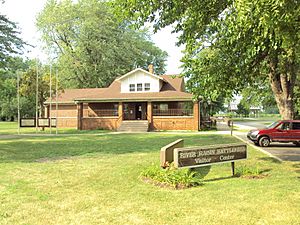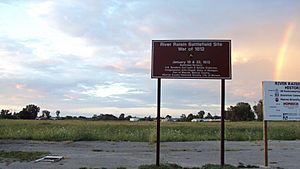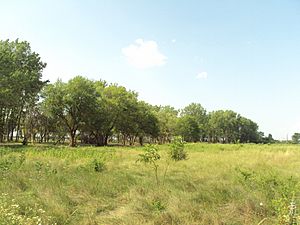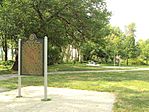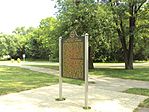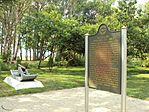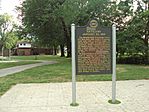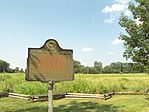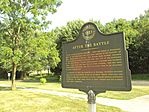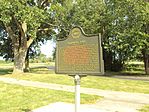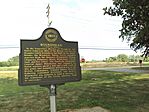River Raisin National Battlefield Park facts for kids
|
River Raisin Battlefield Site (20MR227)
|
|
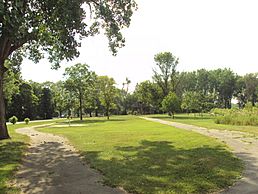 |
|
| Location | Monroe, Michigan |
|---|---|
| Area | 42.18 acres (0.1707 km2) |
| Website | River Raisin National Battlefield Park |
| NRHP reference No. | 82000542 (original) 100003658 (increase) |
Quick facts for kids Significant dates |
|
| Added to NRHP | December 10, 1982 |
| Boundary increase | April 17, 2019 |
| Designated NBP | March 30, 2009 |
The River Raisin National Battlefield Park is a special place that protects the site of the Battle of Frenchtown. It's the only national battlefield that remembers a battle from the War of 1812. This park became the 393rd unit of the United States National Park Service. It was officially made a park on March 30, 2009.
You can find the park in Monroe, a city in Monroe County, Michigan. Before it was a national park, it was named a Michigan Historic Site on February 18, 1956. Later, it was added to the National Register of Historic Places on December 10, 1982. The park officially started welcoming visitors as a national park unit on October 22, 2010.
Contents
The Battle of Frenchtown: A Look Back
The area where the park now stands was once the scene of a very tough battle. This battle was called the Battle of Frenchtown. It was part of the War of 1812, which was fought between the United States and Great Britain. During this battle, many American soldiers lost their lives or were captured.
What Happened During the Battle?
The fighting took place from January 18 to January 23, 1813. At first, American forces had a small victory. This part is sometimes called the First Battle of the River Raisin. But just four days later, on January 22, the British Army and their Native American allies fought back. They attacked the American forces in the same area along the River Raisin.
Many of the American soldiers were new to fighting. They were from Kentucky and were not ready for such a big battle. They found it very hard to escape.
A Difficult Defeat for Americans
During the Battle of Frenchtown, an American general named James Winchester reported sad news. Out of about 1,000 of his men, only 33 managed to get away. A total of 397 soldiers were killed, and 547 were taken prisoner. This made it the deadliest battle ever fought on Michigan soil. It was also the worst single defeat for the Americans in the entire War of 1812.
The day after the main battle, something terrible happened. Many captured American soldiers were too hurt to walk. They were killed by Native Americans, mostly Potawatomi people. This event is known as the River Raisin Massacre. The prisoners who could walk were then marched towards Detroit.
How the Park Grew Over Time
The River Raisin Battlefield Site became a Michigan Historic Site on February 18, 1956. The exact date the park was first set up isn't known. The battle happened in and around the Frenchtown Settlement, which was on the north bank of the River Raisin. This area is now part of Monroe.
The battlefield site was recognized across the country in 1982. It was added to the National Register of Historic Places on December 10, 1982. In July 1990, a Visitor Center was opened at the site. This museum shows some items found from the original battle. Every January, the park holds a special service. It remembers all the soldiers who fought in the Battle of Frenchtown, including the British and Native American fighters.
Making it a National Park
The River Raisin Battlefield Site was chosen to become part of the National Park System. This happened because of a law called the `Omnibus Public Land Management Act`. This law was signed on March 30, 2009. It provided the money needed to make the site a National Battlefield Park.
This park is very special because it's only the fourth National Battlefield Park in the U.S. It's also the only one that remembers the War of 1812. Michigan has other national park units too. These include Isle Royale National Park and Sleeping Bear Dunes National Lakeshore.
The park is still being improved to meet the high standards of the National Park Service. This work depends on getting more money. Building a national park usually takes many years. However, because the local county had already taken care of the battlefield, this park was set up much faster. Some areas still need to be restored to look like they did during the battle.
The park is expected to bring many visitors and help the local economy. In 2012, over 52,000 people visited the battlefield. In 2010, a new nature trail connected the park to the nearby Sterling State Park. This trail helps more people visit both parks.
In 2014, the park grew even more. It added a piece of land that has a historic corduroy road. This road is a part of Hull's Trace, an old military road. It once connected Fort Detroit to Ohio. This new area is managed by several groups working together.
There was also a study in 2017 and 2018 about Fort Wayne in Detroit. People thought it might become part of the national park system, perhaps even a unit of River Raisin National Battlefield Park.
Historic markers




